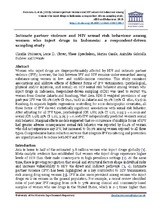| dc.contributor.author | Stoicescu, Claudia | |
| dc.contributor.author | Cluver, Lucie D. | |
| dc.contributor.author | Spreckelsen, Thees | |
| dc.contributor.author | Casale, Marisa | |
| dc.contributor.author | Sudewo, Anindita Gabriella | |
| dc.contributor.author | Irwanto | |
| dc.date.accessioned | 2018-06-18T08:54:26Z | |
| dc.date.available | 2018-06-18T08:54:26Z | |
| dc.date.issued | 2018 | |
| dc.identifier.citation | Stoicescu, C. et al. (2018). Intimate partner violence and HIV sexual risk behaviour among women who inject drugs in Indonesia: a respondent-driven sampling study. AIDS and Behaviour, 2018. | en_US |
| dc.identifier.issn | 1090-7165 | |
| dc.identifier.uri | http://dx.doi.org/10.1007/s10461-018-2186-2 | |
| dc.identifier.uri | http://hdl.handle.net/10566/3815 | |
| dc.description.abstract | Women who inject drugs are disproportionately affected by HIV and intimate partner violence (IPV); however, the link between IPV and HIV remains under-researched among substance-using women in low- and middle-income countries. This study examined associations and additive effects of different forms of IPV victimization (psychological, physical and/or injurious, and sexual) on HIV sexual risk behavior among women who inject drugs in Indonesia. Respondent-driven sampling (RDS) was used to recruit 731 women from Greater Jakarta and Bandung, West Java. RDS-II weighted prevalence of any past-year IPV was 68.9% (95% CI 65.0, 72.6) in Jakarta and 55.9% (95% CI 48.0, 63.5) in Bandung. In separate logistic regressions controlling for socio-demographic covariates, all three forms of IPV showed statistically significant associations with sexual risk behavior. After adjusting for all IPV types, psychological (OR 1.87; 95% CI 1.17, 2.99; p = 0.009) and sexual (OR 1.98; 95% CI 1.22, 3.21; p = 0.006) IPV independently predicted women’s sexual risk behavior. Marginal effects models suggested that co-occurrence of multiple forms of IPV had greater adverse consequences: sexual risk behavior was reported by 64.1% of women who did not experience any IPV, but increased to 89.9% among women exposed to all three types. Comprehensive harm reduction services that integrate IPV monitoring and prevention are urgently needed to reduce both HIV and IPV. | en_US |
| dc.language.iso | en | en_US |
| dc.publisher | Springer | en_US |
| dc.rights | This is the author-version of the article published online at: http://dx.doi.org/10.1007/s10461-018-2186-2 | |
| dc.subject | Intimate partner violence | en_US |
| dc.subject | HIV | en_US |
| dc.subject | Sexual risk behavior | en_US |
| dc.subject | Women | en_US |
| dc.subject | Injecting drug use | en_US |
| dc.subject | Respondent-driven sampling | en_US |
| dc.title | Intimate partner violence and HIV sexual risk behaviour among women who inject drugs in Indonesia: a respondent‑driven sampling study Claudia Stoicescu, | en_US |
| dc.type | Article | en_US |
| dc.privacy.showsubmitter | FALSE | |
| dc.status.ispeerreviewed | TRUE | |

